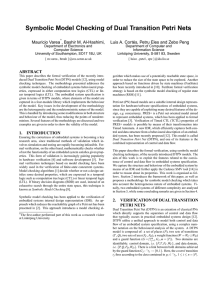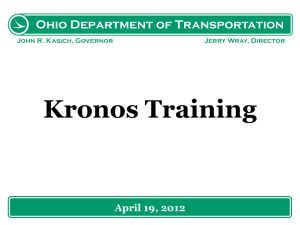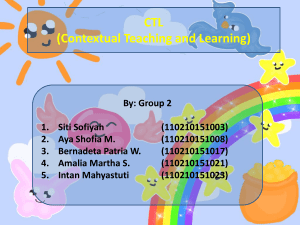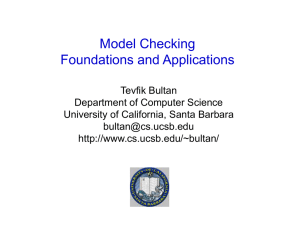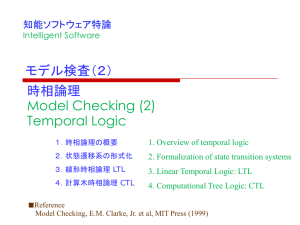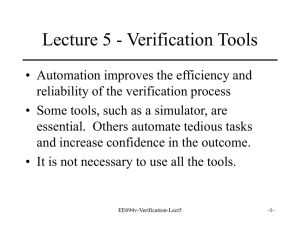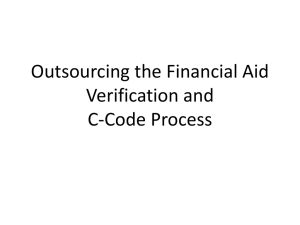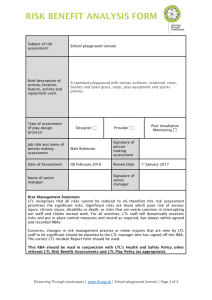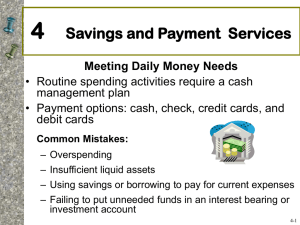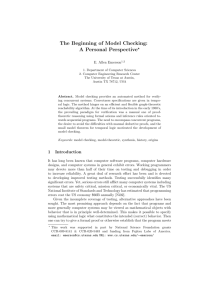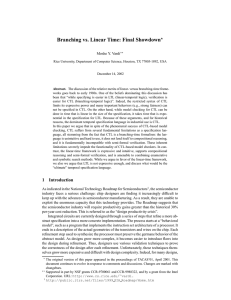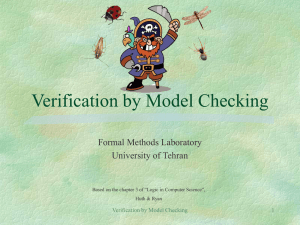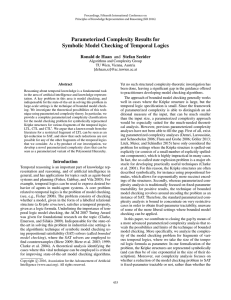Lecture 18: Formal Verification of Digital Systems, by Suraj Sindia
advertisement
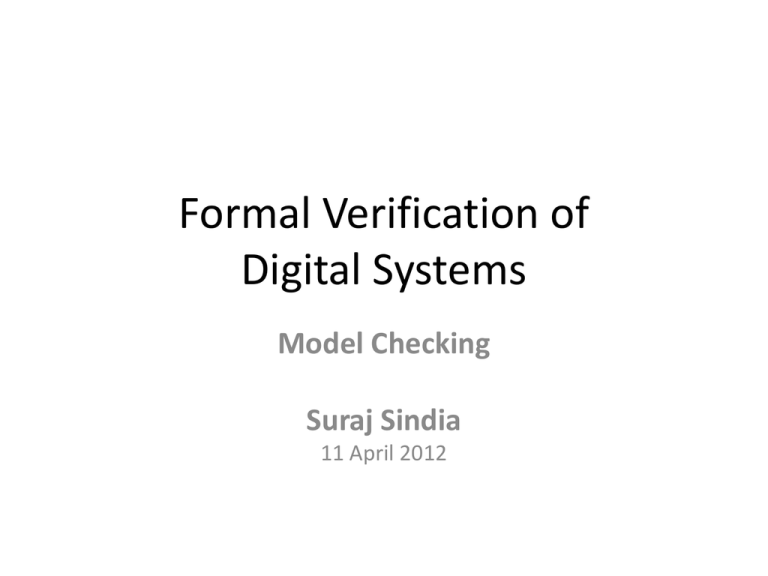
Formal Verification of Digital Systems Model Checking Suraj Sindia 11 April 2012 What is Model Checking? Are we checking these kind of models…? Verification of Circuits • Simulation based verification – Applying a known stimulus to a circuit, and ensuring that all its outputs meet pre-determined performance criteria • Logic simulation – E.g.: ModelSim • Timing simulation – E.g.: HSPICE – Historically most prevalent form of verification – Time for verification grows exponentially with number of inputs • For most real designs, needs application of 60-70% of all input vectors to validate a circuit’s functionality – This implies there is no 100% guarantee that a design is correct! Verification of Circuits • Formal verification – Ensuring that a circuit satisfies (or does not satisfy) all its desired (or undesired) behavior by building a logical formalism – an abstraction – for the circuit being tested – The behavior being tested for, is also expressed in the same abstract form – Some examples: equivalence checking, model checking, static timing analysis (most of us are oblivious to the fact that this is a formal scheme for ensuring timing correctness of a circuit) Formal Verification of Circuits • Primarily is used in two flavors today – – Equality checking • Two implementations of a circuit are formally compared to check if they both are equivalent – For example: Comparing RTL vs. gate level netlist of a design – Formality from Synposys – Model checking • Some behavior of the circuit is abstracted and the following question is posed: – “Does the circuit satisfy this behavior?” – Focus of this and next class Inventors of Model Checking ACM Turing award citation E. Allen Emerson, UT Austin Joseph Sifakis, CNRS Grenoble, France Abstractions for Model Checking • Linear Temporal Logic (LTL) • Computation Tree Logic (CTL) • In this and next class – We will learn these two languages – Use them to specify properties, and verify finite state machines (FSM) Propositional Logic - Basics • • • • • AND (˄) OR (˅) NOT (¬) IMPLICATION (→) BI-CONDITIONAL (↔) Summary of Truth Tables p T T F F q T F T F p∧q T F F F (p ∨ q) p → q p ↔ q T T T T F F T T F F T T LTL for Model Checking: Example 1 LTL for Model Checking: Example 2 LTL for Equivalence Checking Computation Tree Logic (CTL) CTL State Operators: Quick Illustration • Fp – p holds in some future state ~p ~p ~p ~p ~p p x s0 s1 s2 s3 sn sn+1 sn+2 • Gp – p holds globally in future states ~p ~p ~p p p p p s0 s1 s2 s3 sn sn+1 sn+2 x denotes don’t care CTL State Operators: Quick Illustration • Xp – p holds in next state ~p p x s0 s1 s2 • pUq – p holds until q p p p q q x x s0 s1 s2 s3 sn sn+1 sn+2 x denotes don’t care CTL State Operators: Quick Illustration • pWq – p holds until q p p p pvq pvq s0 s1 s2 s3 sn x x sn+1 sn+2 x denotes don’t care CTL Path Operators • A(arg) – Along all paths starting at state s0 arg is True. s0 Example: AGp CTL Path Operators • E(arg) – Along some path starting at state s0 arg is True. s0 Example: EGp References • Logic in Computer Science – Modelling and Reasoning about Systems – 2nd edition of this book by M. Huth and M. Ryan and published by Cambridge press. – Covers all the aspects of LTL and CTL, with several nice examples, that we studied over the last two classes. – Warning: Can be overwhelming in the beginning! • Comprehensive Functional Verification – The Complete Industry Cycle – Authored by B. Wile, J. C. Goss, W. Roesner and published by Elsevier. – 50% of the book is on simulation based verification and the rest on formal verification. – Best practices for verifying large and complex industrial designs are discussed. • http://www.design-reuse.com/articles/2287/survey-comparesformal-verification-tools.html – Survey by Lars Philipson. Gives a list of currently available equivalence checkers and model checkers. Doodles Drawn on Paper Justifications on a Parse Tree for Checking Equivalence of Two Boolean Functions Equivalence Checking Parse Tree for a LTL Formulae Understanding Implication in LTL Verbal Example of an Implication See that converse is not true.
